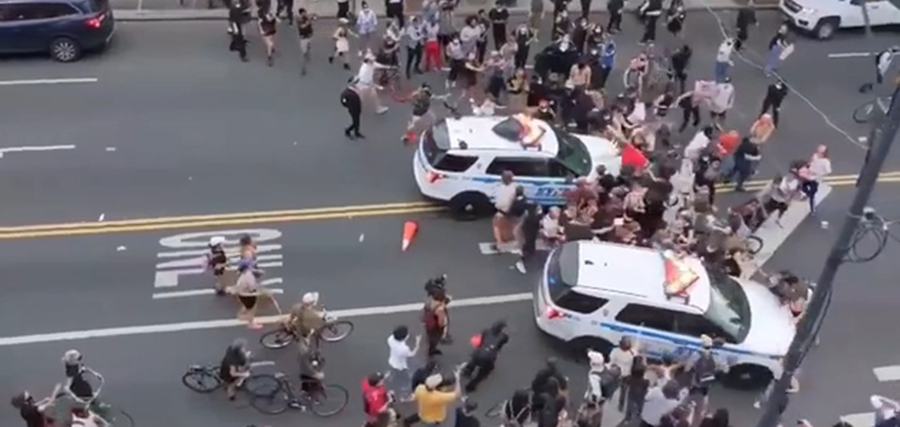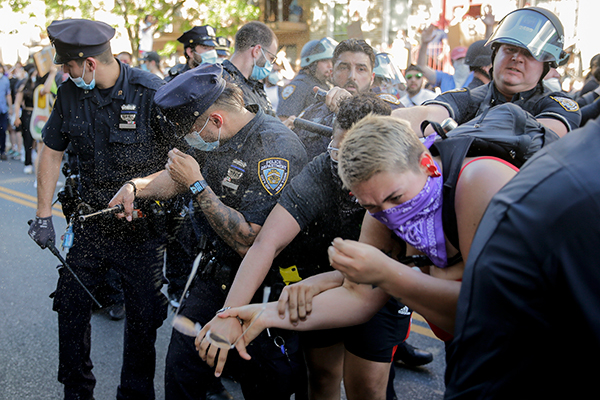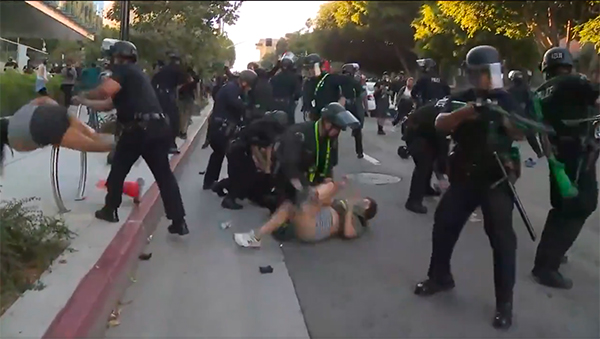NYC’s Own Dept of Investigation Report Details Systematic, Indiscriminate Brutality Against George Floyd Protesters
| revcom.us

Brooklyn, NY, May 30, 2020: The NYPD ran SUVs into crowds of people protesting the murder of George Floyd. Photo: AP
In response to outrage and exposure of police brutality and repression of protests in New York City after the police murder of George Floyd, New York City Mayor Bill de Blasio commissioned a review of police actions by the city’s Department of Investigation (DOI). In December 2020, the DOI released its report. It documents massive, systematic, indiscriminate repression of what it repeatedly acknowledges as “largely peaceful protests.”
- From the report: “DOI’s review of NYPD policies revealed that the Department does not have a policy specific to policing protests or First Amendment-protected expression. Rather, the NYPD Patrol Guide covers demonstrations in policies related to policing of ‘special events,’ such as parades; ‘emergency incidents,’ such as civil disorder; or ‘unusual disorder,’ such as riots.”
- The report documents that the role of the NYPD’s counter-terrorism unit, SRG.29, is to “[r]espond to citywide mobilizations, civil disorder and major events with highly trained personnel and specialized equipment to maintain public order.” [emphasis added]
- The report documents indiscriminate spraying of protesters on June 1 in Midtown Manhattan. Official NYPD policy prohibits indiscriminate spraying of pepper spray. However, “The Chief of Department stated that SRG members [the “counter-terrorism” unit] are authorized to utilize pepper spray for crowd control if approved by a supervisor, and that he approved its use on protesters at the Barclays Center after injuries to officers.”
- While NYPD officials admitted to the DOI that they knew the protests were largely peaceful, “The Department’s public messaging, at times, further reinforced the tensions created by the response strategy, by calling attention primarily to violence and looting without simultaneous acknowledgment of the pain and anger that gave rise to the protests, or due regard for the many individuals airing their grievances with the government in a peaceful manner.”
- While NYPD officials claimed not to know what “kettling” meant, “reports indicate that, in several instances during the Floyd protests, at least some protesters were unable to leave the formations prior to being arrested, although there was no evidence of other criminal activity beyond a curfew violation or physical presence.” That is kettling.
- The DOI reports that arrested protesters “frequently complained that their flex-cuffs were too tight and caused pain or damage—with some alleging long-term nerve damage—to their wrists or hands. When voicing those concerns to their arresting officers or other officers in the area, arrestees were told that the officers lacked the necessary equipment to remove the flex-cuffs.”
- Arrestees “reported that, upon arrival to their arrest processing center, they were denied free calls to legal counsel or family, kept in custody for extended periods, oftentimes in crowded cells, and denied personal protective equipment to include face coverings and hand sanitizer. Several arrestees additionally reported that their personal property was destroyed or confiscated during mass arrests related to the protests.”
- While the report does not focus on individual instances of police brutality, it acknowledges they were “widely reported, such as the police vehicle in Brooklyn driving into a crowd, excessive use of batons, and use of pepper spray.”
- The DOI cites representatives of the mayor’s office “in the field during the protests confirmed observing instances that they believed to constitute disproportionate force by officers, including punching, kicking, tackling, or using batons to strike protesters.”
- The report documents police targeting elected officials, medical personnel in uniforms, and legal observers. At one protest, legal observers were “reportedly zip tied and shoved to the street, when police executed mass arrests for curfew violations.” And it documents that at another protest, medical workers were “pushed, threatened, detained, and arrested, despite the fact that their clothing, documents, and actions clearly identified them as health workers whose sole purpose was rendering necessary medical care.”
- The DOI reported that “When DOI asked NYPD officials whether, in retrospect, the Department could have done anything else differently and made any further changes to improve its response to the protests, with few exceptions, officials offered none.” And even after the protests, after public outrage, and after implementing some reforms, NYPD “training remains heavily focused on disorder control methods, without a sufficient community affairs or de-escalation component.”
The DOI is not a human rights group, an NGO, a civil liberties organization, much less an organization opposing police brutality and murder. It is an official city agency, accountable to the same officials as the head of the NYPD.
The report states explicitly why the DOI is acknowledging what protesters and millions who saw police brutality against protesters have been saying all along: “When a police officer is seen as unnecessarily impatient, rude, brutal, or otherwise unfair in dealing with a protester, people are more likely to view the police (and the law more generally) as illegitimate.”

Brooklyn, NY, May 30, 2020: peaceful protesters react to the NYPD use of pepperspray. Photo: AP
Get a free email subscription to revcom.us:


